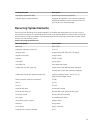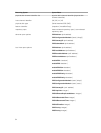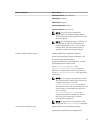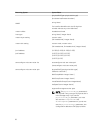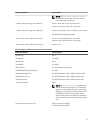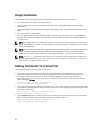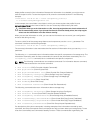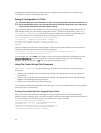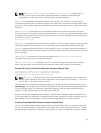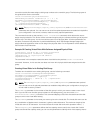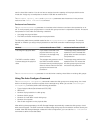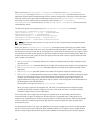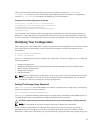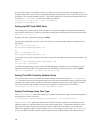
display buffer to see all of the information. Because this information is so detailed, you might want to
save the output to a file. To save the output to a file, enter the command as shown in the following
example:
client>smcli 123.45.67.89 -c "show storageArray profile;"
-o c:\folder\storageArrayprofile.txt
In this example, the name folder is the folder in which you choose to place the profile file, and
storageArrayprofile.txt is the name of the file. You can choose any folder and any file name.
CAUTION: When you write information to a file, the script engine does not check to determine if
the file name already exists. If you choose the name of a file that already exists, the script engine
writes over the information in the file without warning.
When you save the information to a file, you can use the information as a record of your configuration
and as an aid during recovery.
To return a brief list of the storage array features and components, use the summary parameter. The
command is similar to the following example:
client>smcli 123.45.67.89 -c "show storageArray summary;"
The summary information is also returned as the first section of information when you use the profile
parameter.
The following show commands return information about the specific components of a storage array. The
information returned by each of these commands is the same as the information returned by the show
storageArray profile command, but is constrained to the specific component.
NOTE: The following commands are not complete commands. For information about a command,
see the referenced section next to the command.
• show controller (RAID Controller Module Commands)
• show physicalDisks (Show Physical Disk)
• show physicalDiskchannels stats (Show Physical Disk Channel Statistics)
• show storageArray hostTopology (Show Storage Array Host Topology)
• show storageArray lunmappings (Show Storage Array LUN Mappings)
• show allVirtualDisks (Show Virtual Disk)
• show diskGroup (Show Disk Group)
• show virtualDisk reservations (Show Virtual Disk Reservations)
The following commands also return information about a storage array:
• show storageArray autoConfigure (Show Storage Array Auto Configure)
• show controller NVSRAM (Show RAID Controller Module NVSRAM)
• show storageArray unreadableSectors (Show Storage Array Unreadable Sectors)
• show virtualDiskCopy sourceCandidates (Show Virtual Disk Copy Source Candidates)
• show virtualDiskCopy targetCandidates (Show Virtual Disk Copy Target Candidates)
• show virtualDisk performanceStat (Show Disk Group Import Dependencies)
For descriptions of the show commands, including examples of the information returned by each
command, see Script Commands. Other commands can help you learn about your storage array. To see
a list of the commands, see Commands Listed By Function. These commands are organized by the
41



